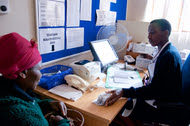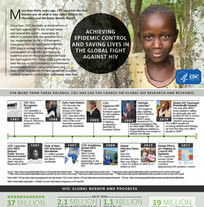
On this World AIDS Day, CDC releases new data affirming that global efforts to end HIV are working. While recent data demonstrate strong progress against HIV, achieving epidemic control requires we focus on those groups at greatest risk for transmitting and acquiring the virus. CDC and partners, through the President’s Emergency Plan for AIDS Relief (PEPFAR), are on the frontlines, working side by side with Ministries of Health to accelerate countries’ efforts to reach the most vulnerable populations with targeted HIV prevention and treatment. By using precision public health, CDC is saving lives, contributing to the long-term stability of countries, and making the world a safer place for us all.
Read more below about CDC’s impact in the fight against HIV, our latest research, stories of CDC experts on the frontlines of this epidemic as well as a World AIDS Day statement from CDC’s Director and downloadable resources.
CDC's Impact
As an implementing agency of PEPFAR, CDC and partners are driving global progress in HIV prevention and treatment, and helping move some of the world’s most affected countries toward HIV epidemic control.
 | HIV Care and Treatment
As of September 30, 2017, CDC supported life-saving antiretroviral treatment for 7.3 million people living with HIV – more than a third (35%) of all people on treatment worldwide and more than half (55%) of people on PEPFAR-supported treatment.
|
 Children and HIV Treatment
As of September 30, 2017, CDC, as part of PEPFAR, supported life-saving antiretroviral treatment for more than 388,000 children under the age of 15 around the world.
|
 Voluntary Medical Male Circumcision
CDC supported voluntary medical male circumcision (VMMC) procedures for 7.5 million men in Southern and Eastern Africa – nearly half (49%) of all VMMC procedures supported by PEPFAR to date through September 30, 2017.
|
Latest Research
In advance of World AIDS Day, CDC also released several new analyses highlighting critical progress in the fight against HIV and CDC's leadership on research to strengthen the global response to this epidemic.
- A new analysis by CDC experts in the Morbidity and Mortality Weekly Report show CDC and partners, through PEPFAR, have made significant progress in scaling-up VMMC in Southern and Eastern African countries, but more is needed to reach global VMMC targets. This analysis builds on CDC data published earlier this year in The Lancet Global Health that found VMMC not only helps prevent HIV in men, but could also protect women against other sexually transmitted infections.
- New CDC-supported Population-based HIV Impact Assessments (PHIA) findings from Tanzania and Zanzibar will also be released on World AIDS Day. These results add to recent PHIA data that show that five high-burden countries – Lesotho, Swaziland, Malawi, Zambia, and Zimbabwe – are approaching control of their HIV epidemics.
- A study led by the National Institutes of Health, PEPFAR and CDC and published in the New England Journal of Medicine provides real-world evidence that the scale-up of a combination of HIV prevention methods can substantially reduce new HIV infections in a population.
CDC on the Frontlines
While recent data demonstrate strong progress against HIV, achieving epidemic control requires we focus on reaching populations at greatest risk for acquiring and transmitting the virus. CDC experts are on the frontlines, working with partners to reach the most vulnerable groups including younger women, men under the age of 35, and key populations.
 |
CDC Experts in Action
CDC's Division of Global HIV & TB is home to one of the largest cadres of public health experts – including epidemiologists, health economists, and medical officers – devoted to the prevention and treatment of HIV. On this World AIDS Day, we invite you to hear directly from CDC experts on the frontlines of the HIV epidemic.
|
 |
HIV Overview
For more than three decades, CDC has been at the forefront of the fight against HIV around the world. Our innovative, data-driven approaches help speed progress toward epidemic control and, ultimately, save lives. Learn more about CDC’s history, leadership, reach, and impact in the global HIV response.
|
 |
Stories from the Field
CDC plays a unique role in the fight against HIV – bringing to bear a combination of scientific and technical expertise and on-the ground experience – to drive progress against the disease. Read more about our lifesaving work in action.
|
Resources
To learn more about how CDC is helping countries in the fight against HIV, CDC’s Division of Global HIV & TB offers the following additional resources:

- MMWR article | an analysis on the impact of CDC-supported efforts to scale-up voluntary medical male circumcision in Eastern and Southern Africa
- PEPFAR 2017 fact sheet | highlights PEPFAR’s latest global HIV data
- Summary Sheets | an overview of PHIA data from various countries
- Social media | shareable cards on latest CDC global HIV data to amplify with your networks
No hay comentarios:
Publicar un comentario